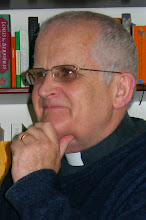D. Mark 8:22 – 10:52 On the Way to Jerusalem
The structure of a story is an important means of picking up signals of how the story is to be read – particularly if you don’t have headings, pictures, bold type or verse numbers we take for granted. Originally, the Gospels had none of these: in fact the Greek text was originally written as one long string of capital letters, no breaks, no punctuation SOMETHINGLIKETHISBUTWRITTENINGREEKNOTENGLISH.
There are a couple of markers (oops!) that tell us that 8:22 – 10:52 needs to be regarded as a unit, and an important one at that. The first of these is that Jesus makes a statement three times: the Son of Man must go up to Jerusalem where he will be rejected by the Jerusalem authorities, undergo great suffering, be put to death and be raised from the dead ”after three days”.(8:31, 9:31, 10:33f.) These three sayings are know as the “passion predictions”.
Each prediction by Jesus is followed by an incident of the disciples misunderstanding what Jesus is saying and a subsequent little block of teaching on the true nature of discipleship.
This section has a great concentration of things to say about Jesus (Christology) and about what it means to follow him: it is “christologically dense”
The story of the transfiguration (9:2-13) forms the mathematical centre point of the Gospel of Mark – count the verses and find the middle.
The block is framed by two giving of sight stories that form the beginning and end. The stories are different – one is a two-stage regaining of sight and one is a discipleship story since the once-blind man now follows Jesus “on the way” up to Jerusalem, exemplifying what it is to be a true disciple. One is set in the Gentile north and the other in the Jewish south. In two different ways, these framing stories use the metaphor of the restoration of physical sight to speak about the gaining of spiritual insight and the beginning of a new life. The Fourth Gospel takes this metaphor even further and uses the giving of sight to a man who has been born blind (John. 9). He is the exemplar of the one who makes the true confession of faith under fire, so to speak.
What we have seen up to this point is a Jesus who is mighty in word and deed, a powerful healer, a divine man. Such healers were “a dime a dozen”, they were men of power. Since such a model does not begin to capture what Jesus is about, we have seen s pretty consistent attempt to hush things up, to keep quiet about such a model of interpreting Jesus – “He commanded them to say nothing!”
What we are about to see is another model they sees powerlessness and humble service of the Son of Man as going to the heart of Jesus. The tension between such contrasting models of power and greatness will provide the occasion for the misunderstandings and teaching.
The structure of this section of the story draws grabs our attention and tells us that we are on holy ground. THISISIMPORTANTSTUFFLETSGOON
Mark 8:22 - 26 First Giving of Sight Story: Gradual Healing
The first framing, giving of sight story is a Gentile story (spitting in the eyes) in a Gentile place to which the disciples had previously been sent (6:45). As such it provides a link, fitting in with what has gone before and helping to frame what is yet to come.
In addition to its Gentile context, it is different from the story of blind Bartimaeus in Jericho (10:46-52) in that (i) it is a two-stage healing, (ii) the healing is described and (iii) it does not exemplify the true Markan response to the word of Jesus in the way Bartimaeus does.
The two-stage healing is often said to provide a model for the response of the disciples. As we will see in 8:29, acclaiming Jesus as Messiah, as Peter does, is quite inappropriate and far from the Markan understanding of Jesus. Peter still has a long way to go!


0 Comments:
Post a Comment
<< Home